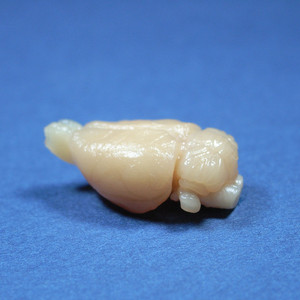Aug. 8, 2008 Research Highlight Biology
Sleepy neurons keep the brain awake
RIKEN researchers are revealing the subtle differences in brain activity when we are awake or asleep
 Figure 1: Rat brain as used to monitor neuron activity in awake or sleeping rats. Copyright © 2008 Tohru Kurotani
Figure 1: Rat brain as used to monitor neuron activity in awake or sleeping rats. Copyright © 2008 Tohru Kurotani
One of the reasons it is often hard to wake up in the morning may be that the brain has to suddenly make huge changes in the way it operates. Some new mechanisms by which the brain reacts to different patterns of electrical neuron firing when we are awake or asleep have now been uncovered by Tohru Kurotani, at the RIKEN Brain Science Institute in Wako, and his co-workers1.
“All living neurons have ‘membrane potential’—a voltage difference between the outside and inside of the cell,” explains Kurotani, who also works at Nagoya University. “When neurons are excited by some stimuli, the membrane potential increases.” Neurons 'fire' when the membrane potential passes a certain threshold.
While we are awake, neurons tend to maintain a high membrane potential and fire repetitively, but while we are sleeping deeply the membrane potential and neuron firing show slow oscillations, called slow-wave sleep. “At the risk of oversimplification, the neurons also ‘sleep’ as we sleep,” says Kurotani.
In their latest study, the researchers gave strong anesthetic to rats that were either awake or in slow-wave sleep, and cut brain slices from their visual cortex (Fig. 1). The slices were used to monitor ‘inhibitory post-synaptic currents’ (IPSCs), which act to lower the membrane potential in a neuron and make it less likely to fire. The IPSCs were found to be larger in rats that had been sleeping.
The researchers believe that while the rats were awake, the firing pattern attenuated the synapses that carry inhibitory signals, but during slow-wave sleep the signals could get through. More specifically, the different firing patterns appear to affect routes by which calcium ions can pass into the cell.
“The physiological meanings of distinctive brain activity patterns during slow-wave sleep or awakening have been unclear because it was technically difficult to perform in vivo experiments,” says Kurotani. “We have overcome this problem by using brain slice preparations and mimicking the distinctive firing patterns during slow-wave sleep or awakening.”
In the future Kurotani hopes to investigate different phases of sleep, such as REM sleep. In these phases our brains may continue to process information, consolidating the memories we gained while awake.
“During [REM sleep], the brain is in an awake-like state, and is thought to be dreaming—possibly keeping some different sort of consciousness,” he explains. “If the dynamics of the brain during different sleep states is revealed, it might provide a clue to explain consciousness.”
References
- 1. Kurotani, T., Yamada, K., Yoshimura, Y., Crair, M.C. & Komatsu, Y. State-dependent bidirectional modification of somatic inhibition in neocortical pyramidal cells. Neuron 57, 905–916 (2008). 10.1016/j.neuron.2008.01.030
